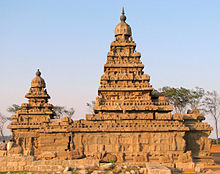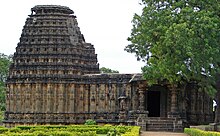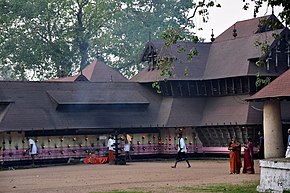Dravidian architecture

Dravidian architecture, or the Southern Indian temple style, is an architectural idiom in Hindu temple architecture that emerged from Southern India, reaching its final form by the sixteenth century.
In contrast with North Indian temple styles, Dravidian architecture uses shorter and more pyramidal towers, called
Mentioned as one of three styles of temple building in early texts on
History
Mayamata and Manasara shilpa texts, which are estimated to have been in circulation by 5th to 7th century CE, is a guidebook on Dravidian style of
Composition and structure
Chola style temples consist almost invariably of the three following parts, arranged in differing manners, but differing in themselves only according to the age in which they were executed:[13]
- The porches or Mandapas, which always cover and precede the door leading to the cell.
- Gate-pyramids, Gopuras, which are the principal features in the quadrangular enclosures that surround the more notable temples. Gopuras are very common in Dravidian temples.
- Pillared halls (Chaultris or Chawadis) are used for many purposes and are the invariable accompaniments of these temples.
Besides these, a South Indian temple usually has a tank called the Kalyani or Pushkarni – to be used for sacred purposes or the convenience of the priests – dwellings for all the grades of the priesthood are attached to it, and other buildings for state or convenience.[13]
Influence from different periods

In Southern India seven kingdoms and empires stamped their influence on architecture during different times:
Sangam period
From 300 BCE to 300 CE, the greatest accomplishments of the kingdoms of the
Pallavas


The
The earliest examples of Pallava constructions are rock-cut temples dating from 610 to 690 CE and structural temples between 690 and 900 CE. The greatest accomplishments of the Pallava architecture are the rock-cut
Contrary to popular impression about the succeeding empire of the Cholas pioneering in building large temple complexes, it was the Pallavas who actually pioneered not only in making large temples after starting construction of rock cut temples without using mortar, bricks etc. Examples of such temples are the Thiruppadagam and Thiruooragam temples that have 28 and 35 feet (11 m) high images of Lord Vishnu in his manifestation as Pandavadhoothar and Trivikraman forms of himself. In comparison, the Siva Lingams in the Royal Temples of the Cholas at Thanjavur and Gangaikonda Cholapurams are 17 and 18 feet (5.5 m) high. Considering that the Kanchi Kailasanatha Temple built by Rajasimha Pallava was the inspiration for Raja Raja Chola's Brihadeeswara at Thanjavur, it can be safely concluded that the Pallavas were among the first emperors in India to build both large temple complexes and very large deities and idols Many of
Kakatiya architecture

Kakatiya architecture was a notable
: 128–140Most of the Kakatiya architecture is influenced from
Badami Chalukyas
The Badami
The most enduring legacy of the Chalukya dynasty is the architecture and art that they left behind. More than one hundred and fifty monuments attributed to the Badami Chalukya, and built between 450 and 700, remain in the
The rock-cut temples of Pattadakal, a UNESCO World Heritage Site, Badami, Aihole and Mahakuta are their most celebrated monuments. Two of the famous paintings at Ajanta cave no. 1, "The Temptation of the Buddha" and "The Persian Embassy" are attributed to them.[21][22] This is the beginning of Chalukya style of architecture and a consolidation of South Indian style.
Rashtrakutas
The
The Rashtrakuta contributions to art and architecture are reflected in the splendid rock-cut shrines at Ellora and Elephanta, situated in present-day
These projects were commissioned by King Krishna I after the Rashtrakuta rule had spread into South India from the Deccan. The architectural style used was partly Dravidian. They do not contain any of the shikharas common to the Nagara style and were built on the same lines as the Virupaksha temple at Pattadakal in Karnataka.[23]
Western Chalukyas

The
The reign of Western Chalukya dynasty was an important period in the development of architecture in the
Their temple building reached its maturity and culmination in the 12th century, with over a hundred temples built across the deccan, more than half of them in present-day Karnataka. Apart from temples they are also well known for ornate stepped wells (Pushkarni) which served as ritual bathing places, many of which are well preserved in Lakkundi. Their stepped well designs were later incorporated by the Hoysalas and the Vijayanagara empire in the coming centuries.Pandya

Cholas

The
The

Temple building received great impetus from the conquests and the genius of
Contrary to popular impression, the Chola emperors patronized and promoted construction of a large number of temples that were spread over most parts of the Chola empire. These include 40 of the 108 Vaishnava
Temple shrine on the
Of course, the two
The temple of
The
Hoysalas

The
The modern interest in the Hoysalas is due to their patronage of art and architecture rather than their military conquests. The brisk temple building throughout the kingdom was accomplished despite constant threats from the Pandyas to the south and the Seunas Yadavas to the north. Their architectural style, an offshoot of the Western Chalukya style,[36] shows distinct Dravidian influences. The Hoysala architecture style is described as Karnata Dravida as distinguished from the traditional Dravida,[37] and is considered an independent architectural tradition with many unique features.[38][39]
Vijayanagara

The whole of
Vijayanagara architecture is a vibrant combination of the
In the 14th century the kings continued to build Vesara or Deccan style monuments but later incorporated dravida-style gopurams to meet their ritualistic needs. The Prasanna Virupaksha temple (underground temple) of Bukka Raya I and the Hazare Rama temple of Deva Raya I are examples of Deccan architecture.[43] The varied and intricate ornamentation of the pillars is a mark of their work.[44] At Hampi, though the Vitthala temple is the best example of their pillared Kalyanamantapa style, the Hazara Ramaswamy temple is a modest but perfectly finished example.[45] A visible aspect of their style is their return to the simplistic and serene art developed by the Chalukya dynasty.[46] A grand specimen of Vijayanagara art, the Vitthala temple, took several decades to complete during the reign of the Tuluva kings.[47]
| Part of a series on |
| Dravidian culture and history |
|---|
 |
| Portal:Dravidian civilizations |
Kerala
The version of Dravidian architecture found in Kerala in the far south-west is significantly different. Very large temples are rare, and sloping roofs with projecting eaves dominate the outline, often arranged in a number of tiers. As in Bengal, this is an adaption to the heavy monsoon rainfall. There is usually a stone core below a timber superstructure. The architecture of Kerala goes back to the Chera dynasty in the 12th century, and a variety of ground plans have been used, including circular ones. The development of multi-building complexes came relatively late.[48]
-
Thirunelli Temple front view
-
Kodungallur Bhagavathy Temple
Sri Lanka
The culture of Sri Lanka is
From the 18th century, Dravidian architecture was heavily adopted by Tamil-speaking populations of Sri Lanka for the construction of Hindu religious sites.[50]
-
The Nalanda Gedige, a Buddhist temple built between the 8th and 10th centuries, in a predominant Pallava style Dravidian architecture.
-
The second Shiva Devale (Shiva temple) of Polonnaruwa, built under the Chola occupation period in 10th century.
-
The Lankatilaka Vihara, a 14th-century building influenced by Dravidian architecture, designed and involving an architect and craftsmen from South India.
-
The Devale asideGampola period, with South Indian architect and craftsmen.
-
Nallur.
-
Jaffna Kingdom. It is built in a Euro-Dravidian style.[51]
-
Corridor ofNaguleswaram Temple
-
Nallur Kandaswamy temple front entrance
See also
| Part of a series on |
| Hinduism |
|---|
 |
- Hindu temples – South India and Tamil Nadu
- Hindu temple architecture – Dravidian style
- Koyil – Hindu temples in Dravidian architectural style.
References
- ^ Fergusson, James (1864). The Rock-cut Temples of India: Illustrated by Seventy-four Photographs Taken on the Spot by Major Gill. J. Murray.
- ISBN 978-0-470-02827-8.
- ^ ISBN 81-208-0223-3
- ^ Tillotson, G. H. R. (1997). Svastika Mansion: A Silpa-Sastra in the 1930s. South Asian Studies, 13(1), pp 87-97
- OCLC 71801033
- JSTOR 3249613.
- ISBN 978-0304707393, Bloomsbury Academic, pp 121-125
- ^ H Kern (1865), The Brhat Sanhita of Varaha-mihara, The Asiatic Society of Bengal, Calcutta
- ^ Mudumby Narasimhachary (Ed) (1976). Āgamaprāmāṇya of Yāmunācārya, Issue 160 of Gaekwad's Oriental Series. Oriental Institute, Maharaja Sayajirao University of Baroda.
- ISBN 978-81-87746-04-1.
- ^ Nagalingam, Pathmarajah (2009). The Religion of the Agamas. Siddhanta Publications. [1]
- ISBN 9780791430682. LCCN 96012383. [2]
- ^ a b Fergusson, James (1997) [1910]. History of Indian and Eastern Architecture (3rd ed.). New Delhi: Low Price Publications. p. 309.
- ^ N. Subramanian (21 September 2005). "Remains of ancient temple found". The Hindu. Archived from the original on 10 November 2012.
- ^ N. Ramya (1 August 2010). "New finds of old temples enthuse archaeologists". The Times of India. Archived from the original on 15 September 2012.
- ISBN 9788170170969.
- ISBN 81-250-2800-5.
- ^ ISBN 9788121210225. Retrieved 14 October 2021.
- ISSN 0971-751X. Retrieved 25 July 2021.
- ^ Over 125 temples exist in Aihole alone, Michael D. Gunther, 2002. "Monuments of India". Retrieved 10 November 2006.
{{cite web}}: CS1 maint: numeric names: authors list (link) - ^ Arthikaje, Mangalore. "History of Karnataka – Chalukyas of Badami". 1998-00 OurKarnataka.Com, Inc. Archived from the original on 4 November 2006. Retrieved 10 November 2006.
- ^ The Badami Chalukya introduced in the western Deccan a glorious chapter alike in heroism in battle and cultural magnificence in peace said art critic K.V. Sounderrajan. They have influenced the architecture in Vengi and Gujarat- Dr. Suryanath U. Kamath (2001), A Concise History of Karnataka from pre-historic times to the present, Jupiter books, MCC (Reprinted 2002), p68
- ^ Takeo Kamiya. "Architecture of the Indian Subcontinent, 20 September 1996". Gerard da Cunha-Architecture Autonomous, Bardez, Goa, India. Retrieved 10 November 2006.
- ^ An important period in the development of Indian art (Kamath 2001, p115)
- ^ Arthikaje. "History of Karnataka – Chalukyas of Kalyani". 1998–2000 OurKarnataka.Com, Inc. Archived from the original on 4 November 2006. Retrieved 10 November 2006.
- ^ Kannikeswaran. "Temples of Karnataka, Kalyani Chalukyan temples". [email protected],1996–2006. Retrieved 16 December 2006.
- ^ See Nilakanta Sastri, K.A. (1955). A History of South India, pp 421
- ^ S.R. Balasubrahmanyam 1975, pp. 18–21.
- ^ "Great Living Chola Temples". Archaeological Survey of India.
- K.A. Nilakanta Sastri, A History of South India, pp 424–426
- ^ Karen Schreitmuller (2012). Baedeker India, pp. 90
- ^ Perniola, V. "The Catholic church in Sri Lanka. The Portuguese period", vol. II, p. 366.
- ^ Bastin, Rohan. The domain of constant excess : plural worship at the Munnesvaram temples in Sri Lanka. pp. 114
- ^ Nagasamy R, Gangaikondacholapuram (1970)
- ^ The bronze image of nataraja at the Nagesvara Temple in Kumbakonam is the largest image known.
- ^ James Fergusson and Henry Cousens write that the Hoysala style has many features in common with that of the Western Chalukya, Arthikaje, Mangalore. "History of Karnataka-Religion, Literature, Art and Architecture in Hoysala Empire". 1998–2000 OurKarnataka.Com, Inc. Archived from the original on 4 November 2006. Retrieved 17 November 2006.
- ^ Adam Hardy. "Indian Temple Architecture: Form and Transformation-The Karnata Dravida Tradition 7th to 13th Centuries, 1995". Vedams Books from India, Vedams eBooks (P) Ltd. Retrieved 17 November 2006.
- Percy Brownwrites that the Hoysala style has negligible influences on the Indo-Aryan style and owing to its many independent features, qualifies as an independent school of architecture, Suryanath U. Kamath, A Concise History of Karnataka from pre-historic times to the present, 2001, Jupiter books, MCC, (Reprinted 2002), p134
- ^ Havell, R. Narasimhachar, M. Sheshadri and S. Settar also claim their style is an independent tradition, Arthikaje, Mangalore. "History of Karnataka-Religion, Literature, Art and Architecture in Hoysala Empire". 1998–2000 OurKarnataka.Com, Inc. Archived from the original on 4 November 2006. Retrieved 17 November 2006.
- ^ Art critic, Percy Brown calls Vijayanagar architecture a blossoming of Dravidian style, Kamath, p182
- ^ Arthikaje Literary Activity}
- ^ "So intimate are the rocks and the monuments they were used for make, it was sometimes impossible to say where nature ended and art began" (Art critic Percy Brown, quoted in Hampi, A Travel Guide, p64)
- ^ Fritz & Mitchell, p9
- ^ Nilakanta Sastri about the importance of pillars in the Vijayanagar style in Kamath (2001), p183
- ^ "Drama in stone" wrote art critic Percy Brown, much of the beauty of Vijayanagara architecture came from their pillars and piers and the styles of sculpting (Hampi, A Travel Guide, p77)
- ^ About the sculptures in Vijayanagara style, see Kamath (2001), p184
- ^ Several monuments are categorised as Tuluva art (Fritz & Mitchell 2001, p9)
- ^ Michell, 155-158
- ^ "Traditional buildings of Jaffna".
- OCLC 31012650.
- ^ "The Nallur Rajadhani".
- S.R. Balasubrahmanyam (1975). Middle Chola Temples. Thomson Press. ISBN 978-9060236079.
- Michell, George, (1977) The Hindu Temple: An Introduction to its Meaning and Forms, 1977, University of Chicago Press, ISBN 978-0-226-53230-1










![Mantri Manai, the remains of the minister's quarters of Jaffna Kingdom. It is built in a Euro-Dravidian style.[51]](http://upload.wikimedia.org/wikipedia/commons/thumb/1/17/Mantri_Manai.JPG/309px-Mantri_Manai.JPG)



